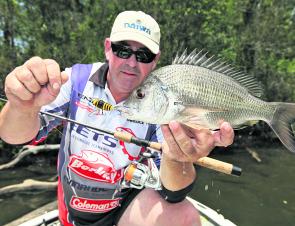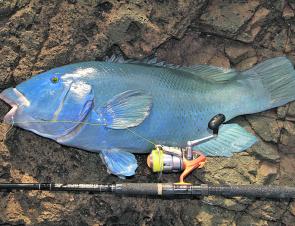No one can deny that 2013/14 has been the best surface bite on bream in a decade. The most dominant factor in the hot bream bite is the deafening resonance of the shoreline cicadas. The lack of rain has helped drive the bream up the rivers en masse with higher salinity and prawn/shrimp growth also contributing to draw the fishes’ attention. The bulk of the cicada species are active from November through to April, and with some luck the hot bream bite will continue for just as long.
It isn’t just the lure anglers who are getting amongst the bream in the rivers. Anglers using baits of prawns and mullet are bagging some good bream and flathead, with the average fish being in the 30cm and 50cm ranges respectively. The bream will hold up the rivers, along with the mullet, until just after Easter, so make the most of it. Even if the intensity of the bite wanes, most of the fish will say up the rivers until the water cools down.
Another thing to be careful of is the numbers of small bull sharks in the rivers. At around a metre it isn’t uncommon to have a one of these frisky sharks nail a hooked fish and, like the taxman, reduce your take home.
In the lower lake there’s plenty of action from a variety of species, including sand mullet and garfish. Bream are holding around the racks, and flathead are scattered around the shallower weed patches of the flats. There have been a few reports of 1m+ flathead and two I know of from the Breckenridge Channel around the new moon period. Whether the big fish are drawn to the channel by the incredibly good prawn run the lake is producing this season or anglers are getting lucky, it must be said there are some quality fish around at the moment.
A run of trumpeter whiting had the deeper channels choked with small tinnies last month, and there should be a few still around leading into March.
Sand whiting have been patchy with some good fish coming from the Tuncurry channel on yabbies and worm. They seem far more receptive to baits at night and at the change of tide under and around the bridge. Grub-tailed plastics like the Gulp Minnow Grubs are ideal lures to sneak across the bottom and encourage the whiting to bite. The odd larger bream is also getting involved in the evening bite around the bridge and nearby leases so consider a leader size around 4.5 kg (10lb).
The Pipers Bay, Forster Keys and the rivers seem to be producing heaps of mud crabs. Talking to Brad at Tuncurry Tackle and Camping it is no wonder, considering the number of traps he sold over the holiday break. Regardless, your single trap needs to be marked as per advice from the DPI website. Blue swimmers are my favourite, and with a string of five hoop nets out during the day your chances of snaring a few blue swimmers is high. Leaving the nets out overnight is not advised, however. Stingrays and cobbler catfish can trash your nets or even relocate them for you.
For those who have a plan for the winter months, now is the time to collect bait, whether it’s prawns to be frozen down or mullet and garfish for the coming tailor season. Prawning is best in early March, while a high tide over weed patches and a little bread berley will sort out the mullet and garfish. When you’re selecting a weedy area for a berley trail make sure there is a drop-off or a bit of depth over the weed. If not, the small bream will drive you crazy.
Fishing offshore has been a hit-and-miss affair, not just with the fish but with the weather as well. Northeasters have been making days at sea patchy or uncomfortable but some good snapper have been hitting the cleaning tables.
The flathead have been in acceptable numbers as well, and grounds off Blackhead have been a favoured area. There have been some big mahi mahi (dolphinfish) off the FAD with one of 16kg I know about. Cobia have been quiet and are perhaps gearing up for a late season run.
In all, March is a great time to fish the lake and even the rivers. The rocks are going through a bit of a season change and spinning for pelagic species is probably the most productive form of fishing.
Reads: 2528
Cicadas are the gun lure. If you haven’t got any, good luck finding some! Everything from Kokoda Bats to Tiemco Bass Tunes are working.

Fishing the rocks at Burgess Beach is a good way to kill some time and catch fish like pigs, bream, tailor and salmon. It will fish even better by the end of this month.

Big blue groper seem to be everywhere at the moment. Releasing these big guys is important.




